
The wormwood pug is a moth of the family Geometridae. The species was first described by Carl Alexander Clerck in 1759. It is a common species across the Palearctic region as well as North America.

The mottled umber is a moth of the family Geometridae. It is common throughout much of the Palearctic region. The species was first described by Carl Alexander Clerck in 1759.
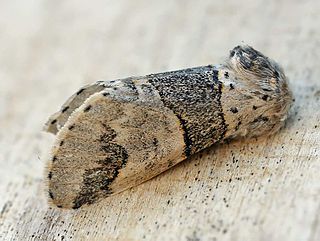
The poplar kitten is a species of moth in the family Notodontidae. The species was first described by Nikolaus Joseph Brahm in 1787. They are found throughout Europe and in North Africa, Mongolia, Kazakhstan and Xinjiang.

The coxcomb prominent is a moth of the family Notodontidae. It is a common species throughout the Palearctic realm from Ireland to Japan. It was first described by Carl Linnaeus in his 1758 10th edition of Systema Naturae.

The buff-tip is a moth of the family Notodontidae. It is found throughout Europe and in Asia to eastern Siberia. The species was first described by Carl Linnaeus in his 1758 10th edition of Systema Naturae.

Furcula furcula, the sallow kitten, is a moth from the family Notodontidae. It was first described by the Swedish entomologist Carl Alexander Clerck in 1759 from a specimen found in Sweden.

Pheosia gnoma, the lesser swallow prominent, is a moth from the family Notodontidae. The species was first described by Johan Christian Fabricius in 1777.
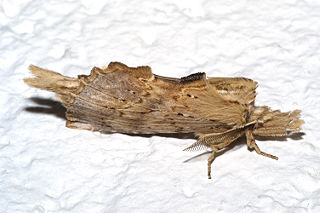
Pterostoma palpina, the pale prominent, is a moth from the family Notodontidae. The species was first described by Carl Alexander Clerck in 1759.

Leucodonta bicoloria, the white prominent, is a moth from the family Notodontidae. It ranges from Western Europe (Ireland) to Hokkaido (Japan) being found in the northern part of Middle Europe, Northern Europe and Russia to the Amur region. In the western parts of the range it is a local and rare species. It is likely extirpated in Britain but a population was recently rediscovered in Ireland. The habitat requirements of the species are a bit unusual, it seems to prefer locally warm deciduous and mixed forests, where birch, the sole host plant, forms the canopy. The moth survives winter as a pupa underground.

Agrochola lota, the red-line Quaker, is a moth of the family Noctuidae. The species was first described by Carl Alexander Clerck in 1759. It is distributed throughout the whole of Europe except Scandinavia; in Armenia, Asia Minor, and east across the Palearctic to the Altai Mountains and western Siberia.It was introduced to Newfoundland. In the Alps, it rises at altitudes of just over 1500 metres.
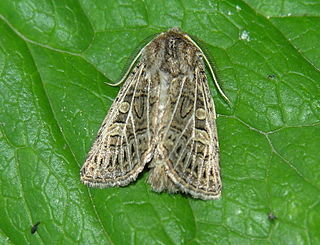
Tholera decimalis, the feathered Gothic, is a species of moth of the family Noctuidae. It is found in Europe and Scandinavia then through the Palearctic to Asia minor, western Central Asia, southern Siberia and in North Africa.
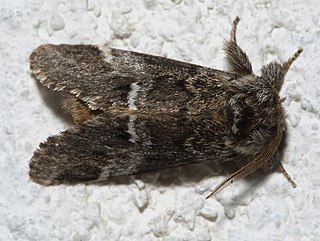
Drymonia dodonaea, the marbled brown, is a moth of the family Notodontidae. The species was first described by Michael Denis and Ignaz Schiffermüller in 1775. It is found in Europe and in the area surrounding the Caucasus.

Drymonia ruficornis, the lunar marbled brown, is a moth of the family Notodontidae. It is found in Central and Southern Europe and Anatolia.

Notodonta dromedarius, the iron prominent, is a moth of the family Notodontidae. The species was first described by Carl Linnaeus in 1767. It is found in Europe and Anatolia.

Notodonta ziczac, the pebble prominent, is a moth of the family Notodontidae. It is found in Europe ranging to Central Asia.
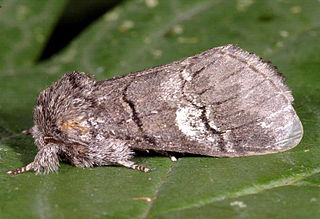
Drymonia querna, the oak marbled brown, is a moth of the family Notodontidae. It is found in the Middle East and mainland Europe except the north.

Odontosia carmelita, the scarce prominent, is a moth of the family Notodontidae. The species was first described by Eugenius Johann Christoph Esper in 1798. It is found in central Europe, ranging to Ireland and Finland in the north and Russia in the east.

Clostera pigra, the small chocolate-tip, is a moth of the family Notodontidae. The species was first described by Johann Siegfried Hufnagel in 1766. It is a Palearctic species found from Europe ranging to Morocco in the south and eastern Asia in the east.

Agrotis ripae, the sand dart, is a moth of the family Noctuidae. The species was first described by Jacob Hübner in 1823. It is found in western Europe and North Africa and extends east across the Palearctic to steppe areas in Russia, Mongolia and Siberia.

Agrotis vestigialis, the archer's dart, is a moth of the family Noctuidae. The species was first described by Johann Siegfried Hufnagel in 1766. It is found in most of the Palearctic realm from Ireland east, through to Russia, Siberia, the Altai Mountains and the Amur region, and is also present in the Mediterranean Basin. It is absent from the north of Finland and Norway.






















